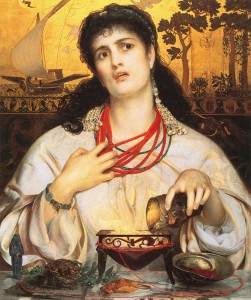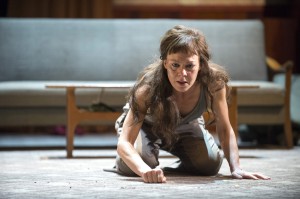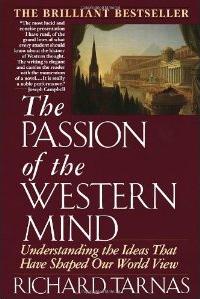 Within fifty years of Sakyamuni Buddha’s death and more than four hundred years before the birth of Yeshua of Nazareth, a play was performed in Athens about a woman so traumatised by grief and humiliation at being abandoned by her husband in favour of another woman, so incensed at the treatment of wives and women of the day, that her rage intensified into an uncompromisingly violent resolve and wish for vengeance; using her skill as a herbalist and sorceress, she created a poison in which she seeped a gorgeous garment which she presented as a deadly wedding gift to her husband’s new consort and, following a crazed and desperate logic, murdered both her children as they slept
Within fifty years of Sakyamuni Buddha’s death and more than four hundred years before the birth of Yeshua of Nazareth, a play was performed in Athens about a woman so traumatised by grief and humiliation at being abandoned by her husband in favour of another woman, so incensed at the treatment of wives and women of the day, that her rage intensified into an uncompromisingly violent resolve and wish for vengeance; using her skill as a herbalist and sorceress, she created a poison in which she seeped a gorgeous garment which she presented as a deadly wedding gift to her husband’s new consort and, following a crazed and desperate logic, murdered both her children as they slept
Watching this terrible story re-enacted anew one and a half thousand years later, streamed live to a local cinema screen from the National Theatre in London, apart from being struck by the sheer power of Helen McCrory’s performance, I found myself weary of the endless rehashing of timeworn stories and of the wallowing in the same old cycle of human suffering, and unconscious and undisciplined emotion on which so much money is expended in the ‘arts’ today. ‘Love and vengeance with a modern twist,’ The Times reported. But how can love and vengeance be connected in the same sentence? They do not share the same universe.
This is not to say that beauty does not figure, nor inspiration, but it surely is less obvious in the mainstream fare offered by TV, film and theatre. Tuning in to any news channel, one wonders if we have learned anything in two and a half thousand years. Hearing what is occurring in some parts of the Middle East, I find myself asking whether what the Christian world perpetrated during the Crusades may be coming back to haunt us.
How wonderful it would be if we could find a way to create an art that is truly new:  that offers not only a new paradigm – both in content and in presentation, but also inspiration to the audience to discover, nurture and cultivate its best and go beyond our present myopic limitations. An art that is not self-righteous or prissy in a false ‘holiness’ or self-conscious ‘sacredness’, but robust and vibrant with an honest clarity and freshness. An art that uses the wizardry of technology, the poetry of language, and the power of design to open perceptual doors and suggest hitherto-uncontemplated possibilities in the audience. An art not once-removed in some devitalised intellectual and academic sense, but rather in the actual spirit of the ancient stage – as a mirror for the soul of the audience, capable of reflecting that which they may as yet not be aware of in themselves.
During the recent retreat in England, we discussed the usefulness of studying and understanding the degree to which our thoughts are not our own, no matter how individual and innovative we deem ourselves to be. The Passion of the Western Mind by Richard Tarnas was recommended for learning where the origins of the paradigms within which we, as westerners, think and the concepts that (mostly unconsciously) shape our thoughts. For centuries we have imbibed ‘focal settings’ and views which operate like familiar wallpaper in the mind; no longer noticed, so deeply do they influence us.
We also practised opening to the ‘feel of the field’ and experimented with the possibility of placing particular energies in the field; energies as simple as those generated by a gentle smile.
As TSK practitioners, we are gifted with not only increasing knowledge and skill, but also are charged with an increasing responsibility for what we contribute to the field by our presence here on Earth at this time.
Perhaps a Multi Media Show based on TSK, and other similar artistic endeavours, could help to introduce new possibilities into our cultural matrix?


